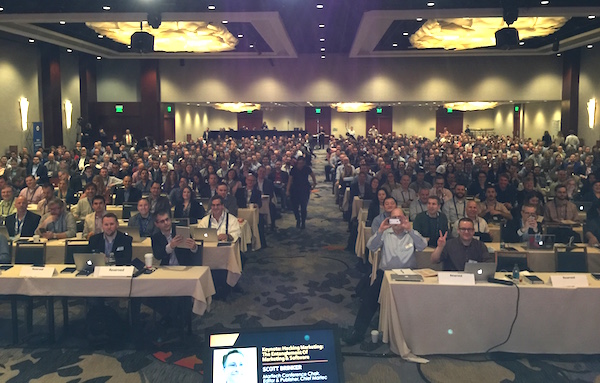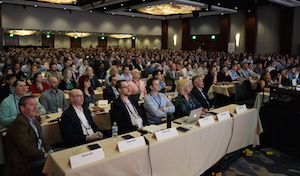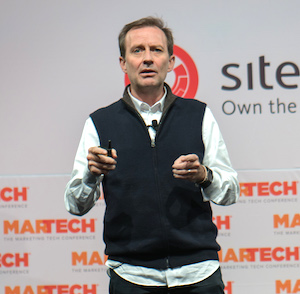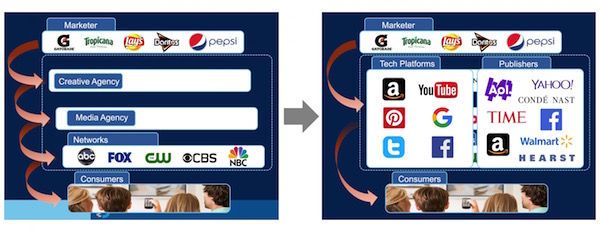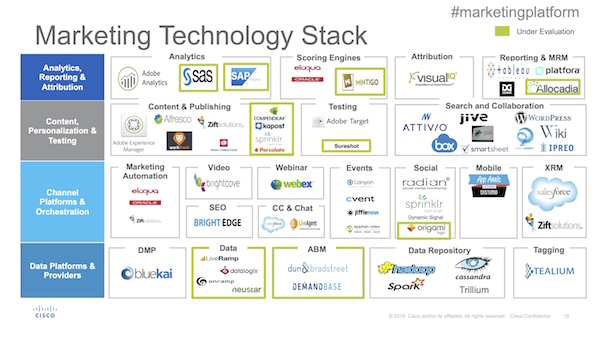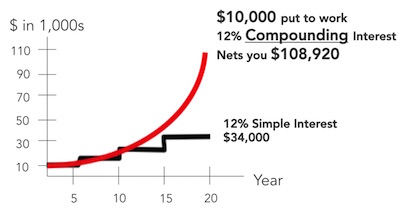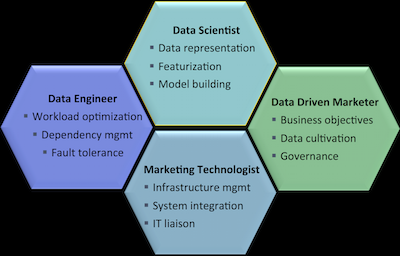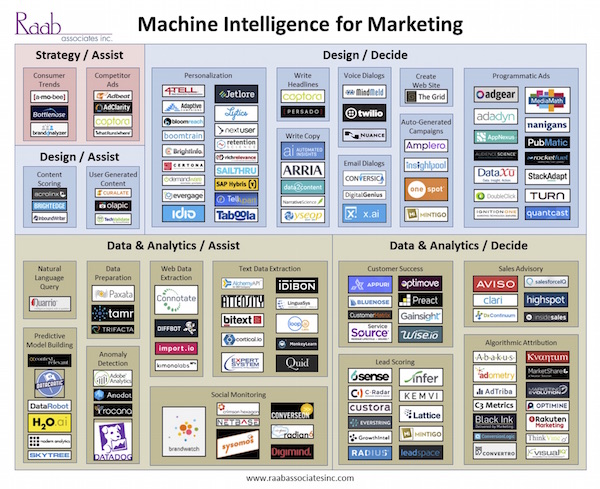It’s been two weeks since MarTech in San Francisco, and I’m just now catching up enough to write down my thoughts about the event.
First and foremost, a heartfelt thank you to everyone who was a part of this conference — attendees, speakers, sponsors, moderators, staff, and the producers behind it all, Third Door Media. I am so grateful to have shared this experience with you.
It was a whirlwind of a conference — a fully sold-out event with over 2,000 participants — and the energy was spectacular. For me, it was like jacking my brain directly into 48 intense hours of high-bandwidth learning, inspiration, and conversation. It renewed my appreciation for the incredible transformation underway in marketing today and all the creative minds striving to shape its future.
However, the explosive growth of the conference wasn’t without growing pains. The exhibit area wasn’t just crowded, but overcrowded. In moving to two session tracks but keeping the 3-short-talks-in-a-row format, attendees rushed between presentations midstream that were halfway across the hotel. The layout of one of the session rooms, with round tables instead of classroom seating, made this even more difficult.
I apologize to everyone who was frustrated or inconvenienced by any of these issues. The entire team involved in putting MarTech together is committed to making the event a great experience on every level. Chris Elwell, the CEO of Third Door Media who produces the event, and I have already spent several hours discussing changes for next year, and we guarantee:
- There will be much more space — we’re expanding to the entire building next year — and we will make sure that both session rooms and exhibit areas are all laid out to comfortably accommodate peak traffic.
- We will rearrange the agenda so that you can get from one session of your choosing to the next more easily.
- We will have more schoolroom-style seating in the session rooms.
- We will have a greater variety of sessions — 3 choices in many time slots — and will do a better job of grouping them by common interests (e.g., perhaps a technical topic track and management topic track).
Please email me at sbrinker@chiefmartec.com if you have any other feedback or suggestions for what you’d like to see next year. Thank you!
Looking beyond the logistics, however, here’s what I believe were the most important themes for marketing overall that emerged from this year’s conference…
#1. The marketing technologist has “crossed the chasm.”
It wasn’t long ago that the “marketing technologist” role was a tentative one — technical talent operating natively in the marketing department (or, if officially reporting into IT, collaborating so closely with marketers as to be indistinguishable from an integral member of the marketing team) — which originally sounded like oil and water.
But it was clear at this MarTech that we’ve graduated from an emerging profession to an accepted one.
The evidence was embodied by many of the speakers — marketing technologists themselves or leaders of teams with marketing technologists embedded in them — who shared stories from companies as diverse as PepsiCo, McKesson, Healthgrades, Clorox, Intuit, Akamai, Cisco, Dell, and so on.
It was also supported by the hundreds of attendees from major brands who had marketing technology in their title or role, including many at VP-level positions, and the topics discussed — a diverse set of critical technology management challenges and opportunities within marketing’s domain that demand this kind of talent.
Actually, while I was at the event, one of the world’s leading financial companies was reaching out to recruit a chief marketing technologist, a position that they saw as vital to their strategic future. A couple of months ago, I saw that a sandwich franchise had posted a job listing for a VP of Marketing Technology. You don’t get more mainstream than this.
However, there is still enormous variance in the nature of marketing technologists and their roles and responsibilities in different firms. If you haven’t yet, please participate in our 2nd almost-annual marketing technologist survey to help us shed more light on the state of our profession.
#2. Martech is eating adtech — and the big gulp is still ahead.
Dave Morgan, one of the icons of the adtech world, gave a phenomenal presentation, Marketing Technology Will Eat Adtech: Soon. “The fast-emerging future state of all media, marketing, and communications channels: people-based, outcome-driven, directly-measured, and digitally integrated.”
He discussed six implications of that — including the scary prediction for many adtech vendors that intermediaries-to-intermediaries, which constitutes 90% of the digital ad market today, will shrivel, and only intermediaries-to-principals (consumers and marketers) will thrive.
But it was his fifth implication that really stuck with me, where he made three points:
- Marketing (and commercial communication management) becomes true core competency for successful enterprises.
- More functions insourced.
- More direct investment in tech & data.
Marketing becomes a core competency. Let that sink in, as it shouldn’t be taken for granted, and it implies a massive shift in resources from agencies and other intermediaries to internal marketing teams — many of whom will invest it in their own technology and data capabilities — that has only barely begun.
Advertising will be a part of that, but operationally, probably a relatively small part. Ads are only a tiny fraction of the total customer journey. Their effectiveness will be evaluated in the context of the overall experience — a far bigger mission.
Earlier that day at MarTech, Ashwin Nathan, senior director of D3 Studios and e-commerce at PepsiCo — “D3” stands for design, digital, and demand — demonstrated how that’s working in practice, sharing how their “in-house agency” (and I personally don’t think that label does them enough justice) had achieved:
- Higher consumer engagement
- Reduced time to market
- Significant production savings
- Accelerating marketing technologist capabilities
PepsiCo still works with external agencies, but they’re developing their own core competency in this new kind of marketing, and not relying on an outside Don Draper. “Don Draper is dead,” declared Ashwin. By the way, case in point on the mainstreaming of marketing technologists was this illustration in Ashwin’s presentation:
#3. Best-of-breed marketing technology stacks are thriving.
There was overwhelming evidence at MarTech that marketers are favoring heterogeneous approaches to building out their marketing technology capabilities.
The 41 marketing tech stacks entered in the Stackies included dozens of terrific examples of how to assemble these pieces together in a rational way. It’s not “shiny object syndrome” run amok. It’s a considered balance of core platforms augmented with specialized point solutions (which shouldn’t be a negative label — see in defense of marketing technology point solutions from 3 years ago).
Many of the speakers also offered glimpses into the marketing technology stacks at their companies — such as this example from Joseph Puthussery, VP of digital marketing at Cisco, in his great presentation on sales and marketing alignment empowered by these technologies, A Balance Struck:
On the supply side, there was also, of course, the continued expansion of the 2016 marketing technology landscape, demonstrating that many entrepreneurs and investors still see new opportunities to innovate different facets of this space. We may be nearing “peak martech” with regard to the total number of active vendors — indeed, we may finally see that number pull back within the next year — but it’s unlikely that the total will dramatically shrink in the near future (at least not until the singularity).
Even all of the major platform vendors who joined me for a fireside chat — Google, Marketo, Oracle, and Salesforce — acknowledged that multi-vendor marketing tech stacks were the reality of the market.
Several of the sessions at MarTech focused on the best ways to architect and manage these best-of-breed stacks — you might find these decks helpful:
- Mythbusters: 10 Myths MarTech Vendors Tell by Theresa Regli of Real Story Group
- Best of Breed: The DNA of Unicorns by Isaac Wyatt of New Relic
- Building Your Ultimate MarTech Stack by Travis Wright of CCP Global
- One Profile to Serve Them All by Troy Steen of Dell
#4. Agile marketing is crossing the chasm too.
Agile marketing — the adaptation of agile management methodologies such as Scrum and Kanban and home-grown variants of them for marketing teams — is also crossing the chasm from early adopters to more mainstream organizations.
The reasons for this are straightforward — the iterative, transparent, and distributed leadership characteristics of agile are well suited to a marketing environment where:
- opportunities and threats are rapidly and continuously changing;
- the digital fabric enables (and incentivizes) greater experimentation;
- the number of simultaneously moving parts has grown exponentially;
- true customer-centricity demands that we frame marketing activities around customer stories and respond swiftly to customer feedback.
The agile marketing panel at MarTech — pictured above — included Roland Smart, VP of Social & Community Marketing at Oracle and author of The Agile Marketer; Jascha Kaykas-Wolff, CMO of Mozilla and author of the agile management book Growing Up Fast; David Lesue, creative director at Workfront, a company that makes work management software that support agile practices; and Barre Hardy, a consultant at CMG Partners, who helps companies adopt agile marketing.
With a wide range of experiences working with many different kinds of organizations, all of these agile marketing leaders had the same message: agility is no longer an option, it’s a mandate for survival.
There’s a reason why the largest section of my book, Hacking Marketing, is an executive’s guide to adopting agile marketing — without an agile “mangement metabolism” in place, none of the other opportunities that marketing has to accelerate its innovation are feasible. You simply can’t operate on a top-down quarterly or yearly cadence and keep up with the digital world today.
Many of the other speakers at MarTech incorporated agile management into their stories as well, such as:
- A Herculean Story From Intuit’s Global Marketing Automation Rollout by Jaemi Bremner of Intuit and Pat Spenner of CEB Marketing
- Agile Marketing Measurement by Shubu Mitra of Coca-Cola and Jennifer Zeszut of Beckon
- Scaling Innovation by Christopher Penn of SHIFT Communications
- Agile Marketing: Your Key to Becoming a Modern Marketer by Brent Bird and Chris Savoie of Workfront
One of the best metaphors for expressing the value of agile marketing was shared by Shubu Mitra of Coca-Cola and Jennifer Zeszut of Beckon in their presentation: the concept of compound interest.
If you are able to make incremental improvements with every iteration of marketing’s strategy and execution, then the difference between iterations that happen yearly vs. iterations that happen every few weeks is — like compound interest — enormous in its collective impact over time. It has the potential to tap exponential dynamics.
And speaking of exponential dynamics…
#5. Cognitive computing is coming to marketing frighteningly quick.
Two of my favorite analysts in the marketing world are David Raab of Raab Associates and Gerry Murray of IDC, both of whom I respect enormously.
It was not a coincidence that, independently, they both concluded that the most important topic that they could share at MarTech was the rise of cognitive computing and machine intelligence in marketing.
Gerry’s presentation, Cognitive Marketing: The Rise of the Super Intelligent Marketer, presented an excellent orientation to what cognitive software is and how it’s being applied to marketing — from chat bots to recommendation engines, real-time sentiment analysis to buyer journey visualization. He foresees a very different kind of “cognitive marketing team” that has a data-driven marketer supported by a data scientist, a data engineer, and a marketing technologist.
“But what about creative?” you might ask.
David’s presentation, How Machine Intelligence Will Really Change Marketing — or — How to Market With Smart Machines Without Ensuring the Destruction of Mankind or Losing Your Job, showed that machine intelligence is already powering a number of key marketing technology applications — including “creative” tasks, such as writing copy and headlines, creating websites, and designing campaigns that most people don’t think a computer can do today:
This is The Second Machine Age. And the exponential acceleration of machine intelligence means that things we thought of as implausible science-fiction — “a computer can’t do that!” — can very quickly become real.
Looking out over the next several years, this will be, by far, the most disruptive phenomenon in marketing. Not least because, as Gerry pointed out, consumers will be harnessing cognitive computing themselves.
Keep a close eye on this in the year ahead.
Roundup of other MarTech coverage
Here are some of the other articles people have written about their takeaways from this last MarTech conference:
- The three things that people kept talking about at MarTech 2016 by Jason Seeba, Chief Marketing Technologist at BloomReach
- 15 Key Visualizations & Diagrams From #MarTech 2016 by Derek Edmond at KO Marketing
- Career-Climbing Tips for Marketing Tech Pros by Erica Seidel of Connective Good
- 10 myths marketing technology vendors want you to believe by James A. Martin at CIO.com based on the MarTech presentation by Theresa Regli of Real Story Group
- 5 Trends that Stood Out During My 1st MarTech by Julie Brown of Teradata Applications
- How Context is Becoming King for Marketers: 3 Key Learnings from MarTech 2016 by Sam Melnick of Allocadia
- Top 3 Themes from the 2016 MarTech Conference by Whitney Harmel of Brandobility
- 3 Takeaways from the MarTech Conference 2016 by Roland Meyer at Salesforce
- The Future of MarTech Centers On Customer Experience by Derek Walter at CMSWire
- MarTech Still Neds a Human Touch by Derek Walter at CMSWire
- MarTech Maturity: The Platforms are the Problem by Derek Walter at CMSWire
- Five Marketing Lessons From MarTech 2016: Where Marketing And Technology Collide by Shep Hyken at Forbes
- MarTech Conference: Marketers are going Agile to keep up with customers by Barry Levine at MarketingLand
- MarTech Conference: Ultimate guide to building a martech stack by Nancy White at MarketingLand
- Marketing technologists: Here are eight steps to boost your info security by Barry Levine at MarketingLand based on Sheldon Monteiro of SapientNitro and Thom Langford of Publicis’s presentation
Thanks again to everyone for an amazing conference. I can’t wait to see you at the next one!
